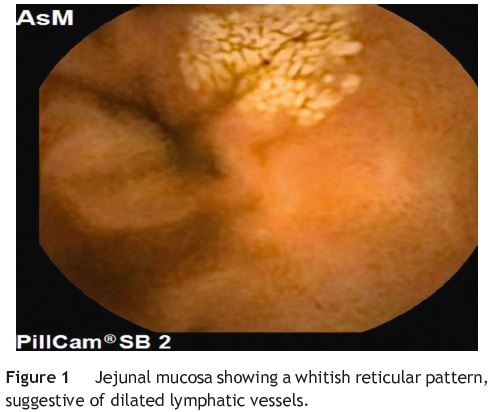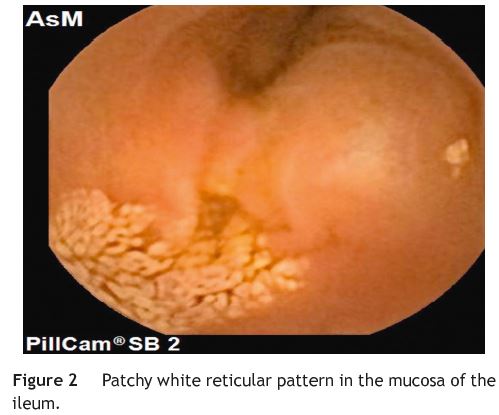Serviços Personalizados
Journal
Artigo
Indicadores
-
 Citado por SciELO
Citado por SciELO -
 Acessos
Acessos
Links relacionados
-
 Similares em
SciELO
Similares em
SciELO
Compartilhar
Jornal Português de Gastrenterologia
versão impressa ISSN 0872-8178
J Port Gastrenterol. vol.19 no.4 Lisboa jul. 2012
Whipples disease and giardiasis: An uncommon association
Doença de whipple e giardíase: uma associação incomum
Frederico Ferreira∗, Helder Cardoso, Andreia Albuquerque, Fernando Magro, Guilherme Macedo
Gastroentrology Department, Hospital S. João and Faculty of Medicine, Porto, Portugal
*Corresponding author
Whipples disease is a rare systemic disorder with unspecific signs and symptoms, that remains a diagnostic challenge.1
A 61-year-old female was referred to the gastroenterology department due to abdominal pain, diarrhea and arthralgias. The investigation revealed anemia, hypoalbuminemia and inflammatory markers elevation, with normal immunological investigation. Fecal smears were positive for Giardia lamblia, but after effective treatment she remained symptomatic. Colonoscopy was normal and the upper endoscopy revealed edematous mucosa on the second duodenal portion. Histopathology of the duodenal biopsy revealed macrophages infiltration, inconclusive for periodic acid-schiff and negative for Ziehl---Nielsen stains. However, polymerase chain reaction (PCR) for Tropheryma whipplei was positive. A capsule endoscopy revealed areas of whitish reticular pattern and dilated villi with lymphangiectasias in the jejunum and ileum (Figs. 1 and 2), changes suggestive of Whipples disease. Antibiotherapy with ceftriaxone followed by trimethoprim-sulfamethoxazole was done. After eight months of treatment, the patient was asymptomatic; anterograde and retrograde single-balloon enteroscopy were performed revealing resolution of the lesions, and the biopsies had negative histological findings and PCR for Tropheryma whipplei.


There are few reports regarding the appearance of the small bowel in Whipples disease as viewed by capsule endoscopy, but a pattern of mucosal involvement with patchy white-yellowish punctate miliaria is considered suggestive.2,3 However, in the present case these changes occurred throughout the jejunum and ileum and were absent in the duodenum. The areas readily accessible for biopsy were therefore scarcely affected, which explains the absence of typical histological changes and reinforces the importance PCR and capsule endoscopy for diagnosis.
In conclusion, this case is original for the presence of lesions in the jejunum and ileum with sparing of the duodenum, rending diagnosis even more challenging. This patient had also simultaneous infection with Giardia lamblia which is an uncommon association, whose etiology is still a matter of debate.4,5
References
1. Fenollar F, Puechal X, Raoult D. Whipples disease. New England Journal of Medicine. 2007;356:55-66. [ Links ]
2. Fritscher-Ravens A, Swain CP, Von Herbay A. Refractory Whipples disease with anaemia: first lessons from capsule endoscopy. Endoscopy. 2004;36:659-62. [ Links ]
3. Gay G, Roche JF, Delvaux M. Capsule endoscopy, transit time, and Whipples disease. Endoscopy. 2005;37:272-3. [ Links ]
4. Fenollar F, Lepidi H, Gerolami R, et al. Whipple disease associated with giardiasis. Journal of Infectious Diseases. 2003;188: 828-34. [ Links ]
5. Fernandez-Urien I, Carretero C, Sola JJ, et al. Refractory Whipples disease. Gastrointestinal Endoscopy. 2007;65: 521-2. [ Links ]
Conflicts of interest
The authors have no conflicts of interest to declare.
*Corresponding author
E-mail address: fredericoferreira2@hotmail.com (F. Ferreira).
Received 8 July 2011; accepted 10 January 2012













